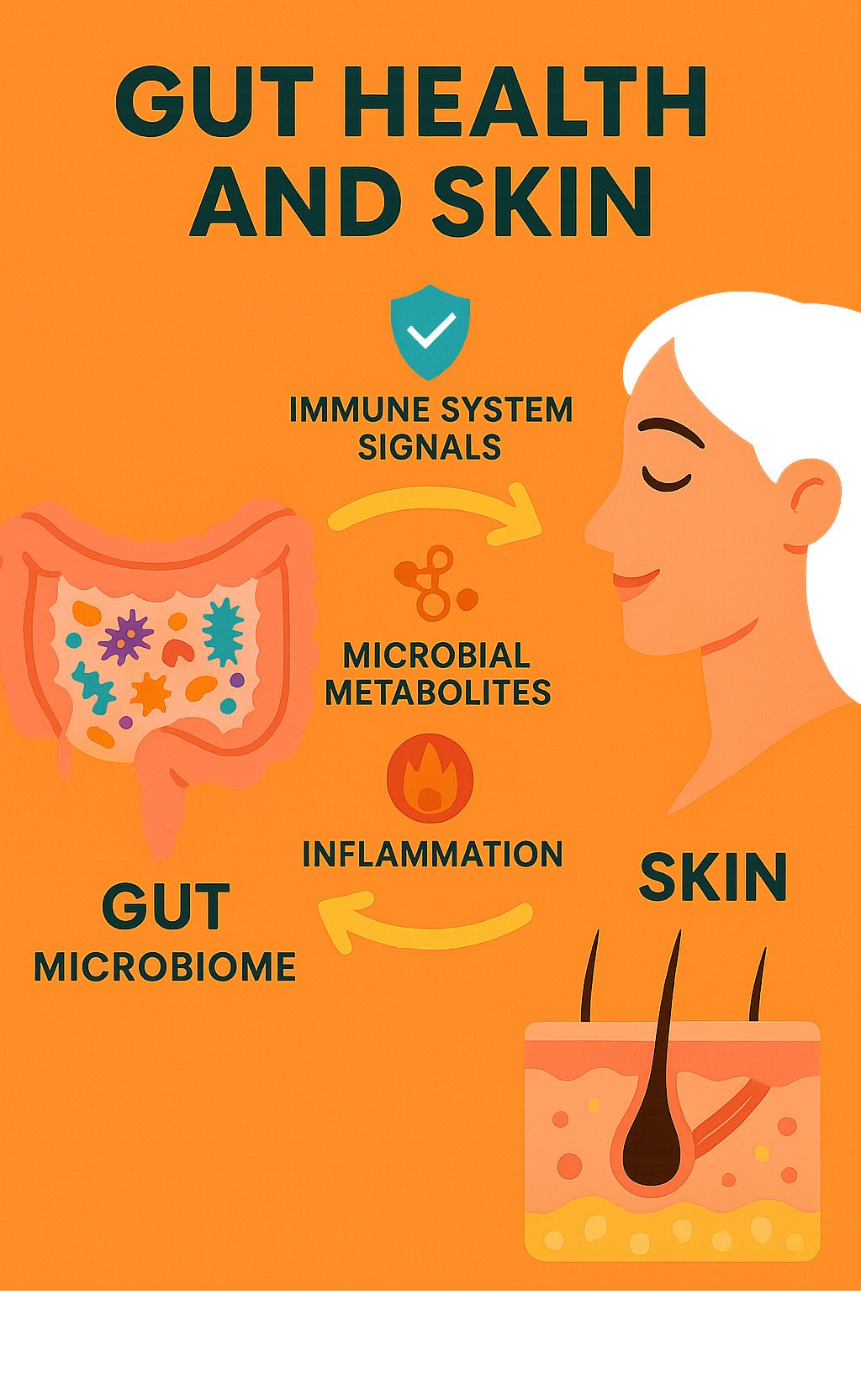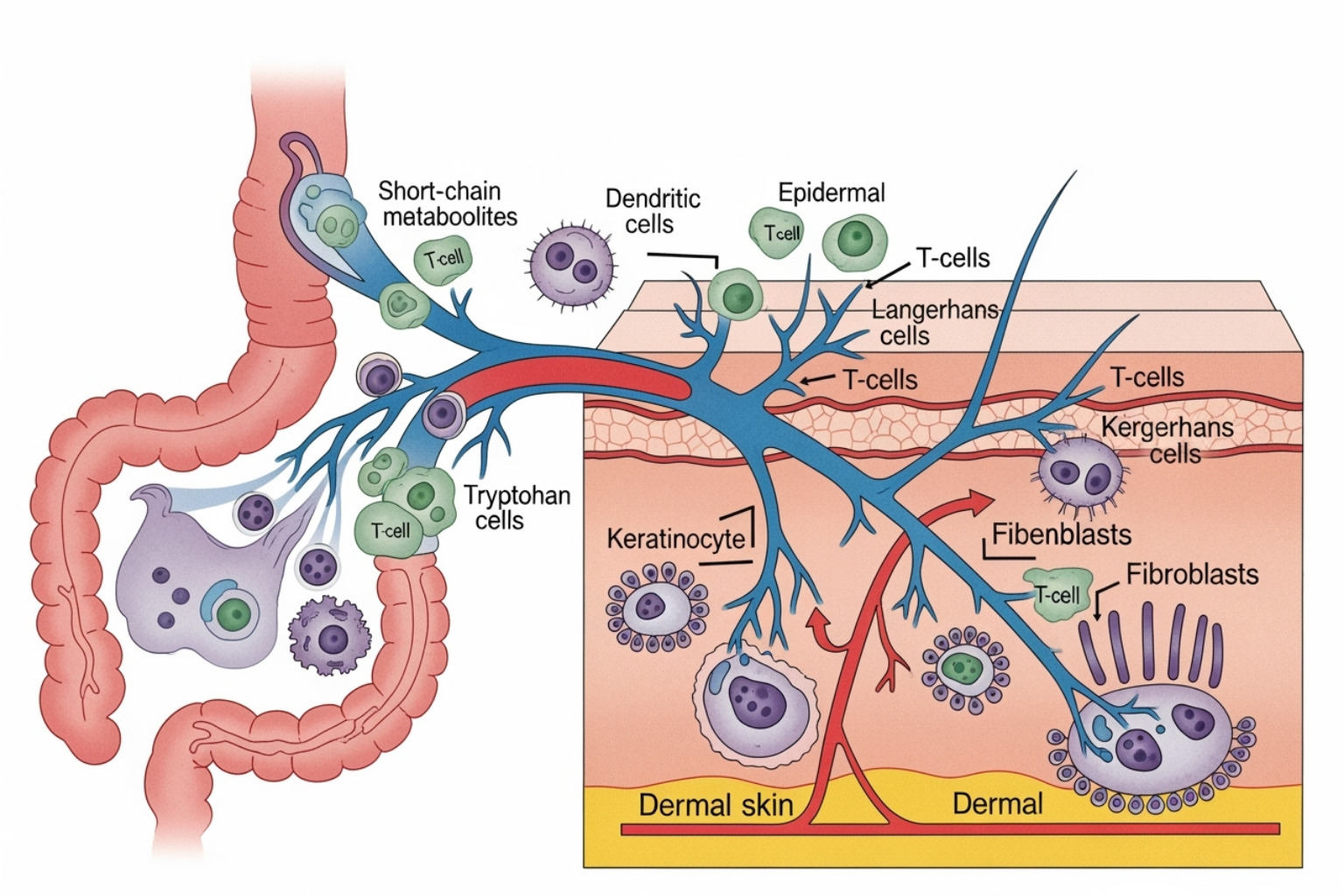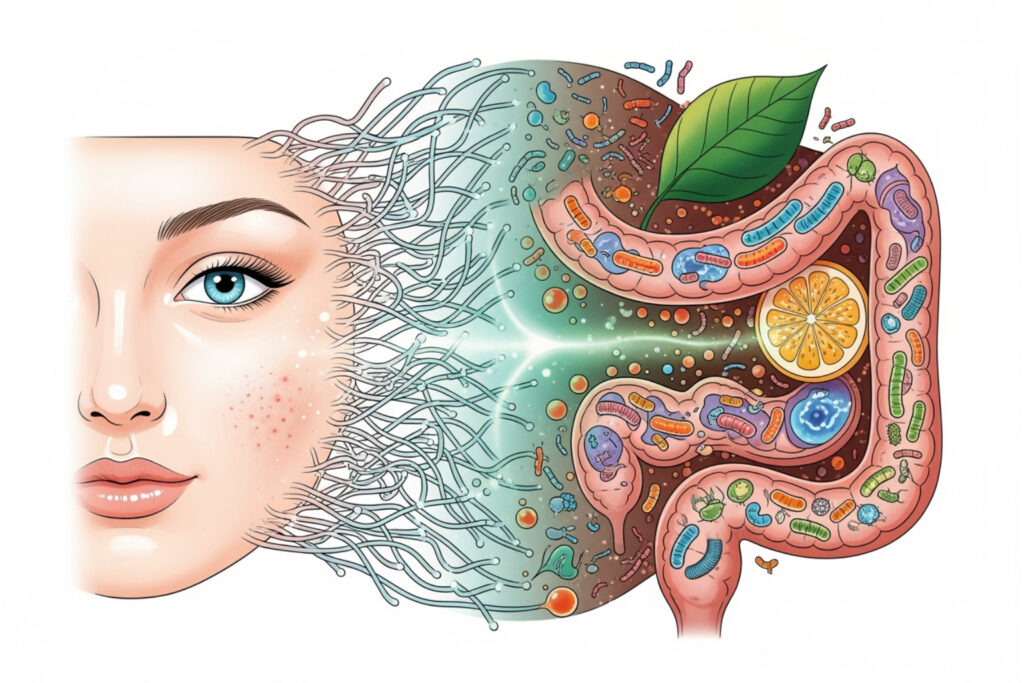Why Gut Health and Skin Go Hand in Hand
The link between gut health and skin is profound. Your skin often reflects your internal wellness, especially the state of your gut.
Here’s the quick truth:
- A Two-Way Street: Your gut and skin constantly communicate via the “gut-skin axis.”
- Microbial Influence: Your gut contains up to 100 trillion microbes, and your skin hosts over 1,000 bacterial species. These microbes are crucial for your health.
- The Importance of Balance: A balanced gut microbiome supports overall health. An imbalance, or dysbiosis, can cause inflammation that manifests as skin problems like acne or rashes.
- Immune System Connection: A significant portion of your immune system resides in your gut. Gut health directly impacts immune responses, which in turn affects your skin.
This connection explains why a sugary meal might lead to a breakout or why food allergies can trigger rashes. It’s the gut-skin axis in action. This link isn’t new; dermatologists noted the connection between stress, gut health, and skin conditions nearly a century ago. Modern science now confirms the depth of this relationship.
Understanding this link is the first step toward achieving that natural, healthy glow from the inside out.

Simple guide to Gut health and skin:
The Gut-Skin Axis: A Deep Dive into the Connection
The gut-skin axis describes the constant dialogue between your gut and skin, a vital connection for maintaining your body’s balance, or homeostasis. This axis highlights how your gut microbiome – the trillions of microbes in your intestines – affects your skin’s health. This bidirectional communication also involves your skin’s own unique microbiome.
Your digestive tract, home to 100 trillion microbial cells, is often called our “second brain.” These microbes aid digestion, nutrient absorption, and immune system training, protecting you from harmful pathogens.
How the Gut and Skin Microbiomes Interact
Both your gut and skin host vast microbial ecosystems. Though located in different parts of the body, they communicate through the immune system and microbial metabolites.
A healthy gut is rich in commensal bacteria, friendly microbes that maintain immune tolerance and prevent harmful pathobionts from taking over. These good bacteria produce beneficial compounds like short-chain fatty acids (SCFAs), which enter the systemic circulation and influence skin health. The gut’s microbial balance can even affect the composition of the skin’s microbiome, demonstrating their deep connection. To dive deeper into this fascinating relationship, you can explore scientific research on the gut microbiome as a regulator of systemic health: Scientific research on the gut microbiome as a regulator.
The Role of the Gut Barrier in Skin Health
Your gut lining, composed of intestinal epithelial cells joined by tight junctions, acts as a selective barrier. This barrier covers an area the size of a tennis court and controls what enters your bloodstream from your gut. A healthy gut barrier allows nutrients to pass through while blocking toxins and undigested food particles.
When this barrier is compromised, the tight junctions loosen, leading to increased intestinal permeability, or “leaky gut.” This allows harmful substances like lipopolysaccharides (LPS) to leak into the bloodstream, causing endotoxemia and systemic inflammation. This immune cell activation can manifest as various skin problems. A strong gut barrier is crucial for preventing internal stress that leads to skin concerns.
Immunological and Metabolic Pathways: How Gut Health and Skin are Linked
How do your gut and skin communicate? It’s a complex system where immune cells and chemical messengers travel from the gut to the skin. This constant flow is how gut health and skin are so closely linked.

Key Immunological Mechanisms
Your gut houses the Gut-Associated Lymphoid Tissue (GALT), a major component of your immune system. Here, immune cells are “trained,” influencing your body’s overall immune responses.
Key players include T-cells. A healthy gut promotes Regulatory T-cells (Tregs), which calm the immune system. Dysbiosis, however, can lead to inflammatory T-cells (like T-helper cells Th1, Th2, and Th17), which can cause inflammation to appear on your skin.
Cytokines are messenger proteins that direct immune cells. A healthy gut promotes anti-inflammatory cytokines like IL-10. An unhealthy gut can lead to an overproduction of pro-inflammatory cytokines, such as TNF-alpha, IL-6, and IL-17, fueling inflammation that affects the skin.
Gut microbes also help produce Secretory IgA (sIgA), an antibody that strengthens the gut barrier. From your body’s first line of defense (innate immunity) to its more specific responses (adaptive immunity), your gut microbiome is a key regulator.
Key Metabolic Mechanisms
Gut microbes also produce metabolic compounds that directly impact your skin.
The most well-known are Short-Chain Fatty Acids (SCFAs), like butyrate, propionate, and acetate, produced when bacteria ferment fiber. SCFAs strengthen the gut lining, reduce inflammation, and can travel to the skin to support cell growth and wound healing.
Gut bacteria also convert the amino acid tryptophan into compounds that modulate immune responses and inflammation. The microbial modification of bile acids is also important; imbalances can affect systemic inflammation and liver health, which in turn impacts the skin.
Additionally, gut bacteria produce essential vitamins like biotin (Vitamin B7) and Vitamin K, which are vital for healthy skin. They can even influence neurotransmitters like serotonin and GABA. This link explains how stress can trigger skin flare-ups, a phenomenon known as the gut-brain-skin connection. For even more fascinating insights into these intricate connections, you can dive into the science behind the gut-skin axis: More on the gut-skin axis in health and disease.
The interplay of these immune and metabolic pathways shows just how deeply gut health and skin are connected. When these systems work in harmony, your skin can truly glow.
When Communication Breaks Down: Gut Dysbiosis and Common Skin Diseases
When the communication between the gut and skin breaks down, gut dysbiosis – an imbalance in your gut’s microbial community – is often the culprit. This imbalance can lead to a ‘leaky’ gut, allowing substances to enter the bloodstream and cause low-grade, systemic inflammation that often manifests on the skin.
Scientists have identified clear links between gut health and several common skin conditions, including:
- Psoriasis
- Atopic Dermatitis (Eczema)
- Acne Vulgaris
- Rosacea
- Alopecia Areata
- Hidradenitis Suppurativa
Let’s explore how an unhappy gut might play a role in each of these.
Psoriasis and the Gut Connection
Psoriasis is an autoimmune condition where the immune system is overactive. Studies show people with psoriasis often have a different gut microbiome, with fewer anti-inflammatory bacteria like Akkermansia and Faecalibacterium. A compromised gut barrier can allow bacterial components to leak into the blood, triggering a body-wide inflammatory response that can worsen psoriasis flare-ups. The skin of psoriasis patients also often has more Staphylococcus aureus, adding to the inflammation. For a deeper dive into this connection, check out this scientific review on psoriasis and microbiota: Scientific review on psoriasis and microbiota.
Atopic Dermatitis (Eczema)
Eczema (atopic dermatitis) involves dry, itchy skin and a weak skin barrier. Its origins can trace back to infancy, where low gut microbiome diversity is linked to a higher risk of developing eczema. In those with eczema, an imbalanced gut often produces fewer beneficial SCFAs, which are crucial for a balanced immune system. This can be compounded by an overgrowth of Staphylococcus aureus on the skin, highlighting how early gut development influences long-term skin health.
Acne Vulgaris and Rosacea
Acne involves clogged pores, excess oil (sebum), and inflammation, often worsened by the bacterium Cutibacterium acnes. Gut health is a key factor, as an imbalanced gut can increase systemic inflammation and affect hormones, both of which influence acne severity. Rosacea, which causes redness and visible blood vessels, is also linked to the gut. Conditions like Small Intestinal Bacterial Overgrowth (SIBO) and infection with Helicobacter pylori are more common in people with rosacea. Treating these gut issues has shown promise in improving rosacea symptoms, showing how a ‘leaky’ gut can fuel the inflammation seen in both conditions.
Alopecia Areata and Hidradenitis Suppurativa
Alopecia Areata (AA), an autoimmune condition causing hair loss, is also being linked to the gut. Research suggests that changes in the gut microbiome and gut-derived immune imbalances may contribute to the autoimmune attack on hair follicles. Hidradenitis Suppurativa (HS), a chronic inflammatory skin disease, often co-occurs with inflammatory bowel disease (IBD), suggesting shared inflammatory pathways. The inflammation in HS may be fueled by gut dysbiosis.
Seeing these connections highlights why looking at your gut health and skin together is vital for managing even the most challenging skin conditions.
Nurturing the Connection: How to Improve Your Gut Health and Skin
Since our gut and skin are so connected, nurturing this axis is key for vibrant skin. Daily choices – from diet and supplements to medication use – can significantly impact our gut microbiome and, in turn, our skin.

The Impact of Diet on the Gut-Skin Axis
“You are what you eat” is especially true for gut health and skin. Your diet is one of the most powerful tools for shaping your gut microbiome, as it directly feeds your gut bacteria.
| Dietary Approach | Impact on Gut Bacteria | Impact on Skin Inflammation |
|---|---|---|
| High-Fiber Diet | Promotes beneficial bacteria (e.g., Bifidobacterium, Lactobacillus, SCFA producers) | Reduces systemic inflammation, supports skin barrier, potentially improves conditions like acne and AD |
| High-Fat/Sugar (Western) Diet | Decreases microbial diversity, increases pro-inflammatory bacteria, can promote dysbiosis | Increases systemic inflammation, contributes to oxidative stress, may worsen acne, rosacea, and other inflammatory skin issues |
A high-fiber diet, rich in fruits, vegetables, legumes, and whole grains, fuels beneficial gut bacteria. As they ferment this fiber, they produce anti-inflammatory SCFAs that strengthen the gut barrier. Fermented foods like kefir, sauerkraut, and yogurt introduce beneficial bacteria directly into your gut. Foods rich in polyphenols, such as berries and green tea, also act as prebiotics, feeding good bacteria and providing antioxidant benefits.
Conversely, a Western diet high in processed foods, sugar, and unhealthy fats can cause gut dysbiosis and inflammation, which can manifest as acne, rosacea, or accelerated skin aging. Breastmilk is crucial for infants, providing prebiotics and probiotics that establish a healthy gut microbiome from birth. The key for everyone is to focus on whole, unprocessed foods.
Probiotics, Prebiotics, and Synbiotics
You can also support your gut with targeted supplements:
- Probiotics are live, beneficial microorganisms. Strains of Lactobacillus and Bifidobacterium have shown promise in studies for reducing the severity of atopic dermatitis and improving acne. When choosing a probiotic, broad-spectrum options with multiple strains are often more effective.
- Prebiotics are non-digestible fibers that feed your good gut bacteria. Common prebiotics like inulin and fructooligosaccharides (FOS) are found in foods like onions, garlic, asparagus, and bananas.
- Synbiotics combine both probiotics and prebiotics. The prebiotic component helps the probiotic strains survive and thrive in your gut, enhancing their benefits.
Response to supplements is individual, so it’s always best to consult a healthcare professional for personalized advice. For some general guidance, the World Gastroenterology Organisation offers helpful guidelines on probiotics: World Gastroenterology Organisation guidelines on probiotics.
The Role of Antibiotics and Other Medications
Antibiotics can be life-saving, but they don’t distinguish between good and bad bacteria. Broad-spectrum antibiotics can disrupt your gut microbiome’s diversity, leading to dysbiosis with lasting effects on your gut and skin. While sometimes necessary, it’s important to use them mindfully and consider strategies like probiotic supplementation to aid recovery.
Finally, lifestyle factors are crucial. Managing stress, getting enough sleep, and regular physical activity are all vital for a healthy gut. When your gut is happy, your skin will often reflect that with a natural glow, embodying a truly holistic approach to wellness.
Frequently Asked Questions about the Gut-Skin Connection
It’s natural to have questions about the practical side of the gut health and skin connection. Here are answers to some of the most common ones.
How long does it take to see skin improvements after changing my diet for gut health?
This is a common question. When you improve your diet for gut health, your gut microbiome can start to change within a few days. However, seeing visible skin improvements takes longer. Skin cell turnover takes about 28 to 40 days, so you need to be patient for at least one full cycle. Most people notice positive changes within 4 to 12 weeks of consistent dietary changes. Consistency is key for long-term results.
Can taking a probiotic supplement clear my acne?
While not a standalone cure, probiotic supplements can be a powerful tool for supporting clearer skin. Acne is complex, with genetic, hormonal, and inflammatory factors. Certain probiotic strains show promise by calming systemic inflammation, helping to balance oil production, and strengthening the gut barrier to prevent inflammatory triggers from entering the bloodstream. Specific strains like Lactobacillus have been studied for these benefits. Probiotics are best used as part of a comprehensive approach that includes a healthy diet, proper skincare, and consultation with a healthcare professional.
Is “leaky gut” a real medical diagnosis?
While “leaky gut syndrome” is not a formal medical diagnosis, it refers to a real, scientifically recognized condition: increased intestinal permeability. Scientifically, this means the tight junctions that line your gut have loosened. In a healthy gut, these junctions are very selective, only allowing digested nutrients to pass into the bloodstream. When these junctions loosen, undigested food particles, toxins, and bacteria can ‘leak’ into the bloodstream, triggering a body-wide immune response and inflammation. Scientists can measure this permeability by looking at markers like zonulin, a protein that regulates these junctions. So, the underlying concept of increased intestinal permeability is well-researched and considered a contributing factor in many health conditions, including skin issues. Addressing it is a key step toward improving your overall gut health and skin.
Conclusion: Your Gut is the Foundation for Glowing Skin
Our journey through the gut-skin axis makes one thing clear: internal health shines through externally. The connection between the trillions of microbes in our gut and the health of our skin is undeniable. Gut health and skin are two sides of the same coin.
We’ve seen how gut dysbiosis can contribute to conditions like psoriasis, eczema, acne, and rosacea. The good news is that you can foster healthier, more radiant skin by nurturing your gut with a healthy diet, probiotics, and mindful habits. The path to glowing skin starts from within.
At Beyond Beauty Lab, we believe in this holistic approach to beauty and long-term wellness. Supporting your gut creates a foundation for lasting health and a natural, vibrant glow. Trust your gut instincts – you might be amazed at how your skin transforms.
For more insights to improve your beauty and well-being, explore our wellness tips.







